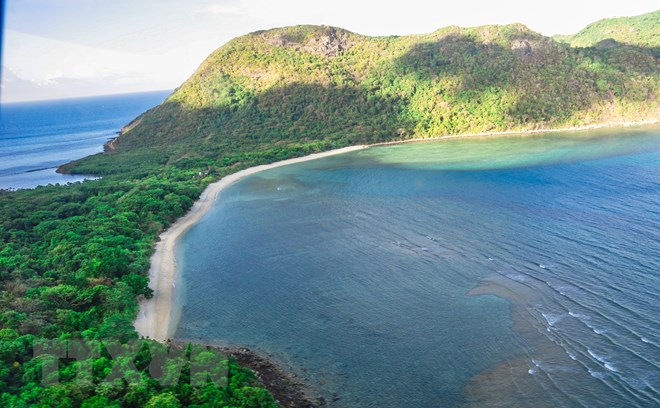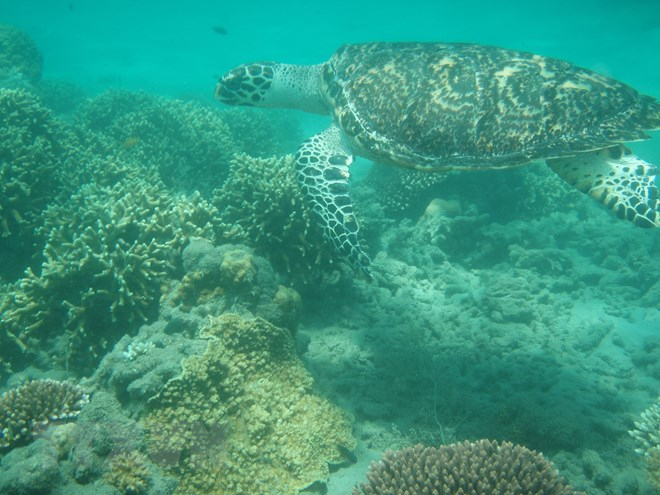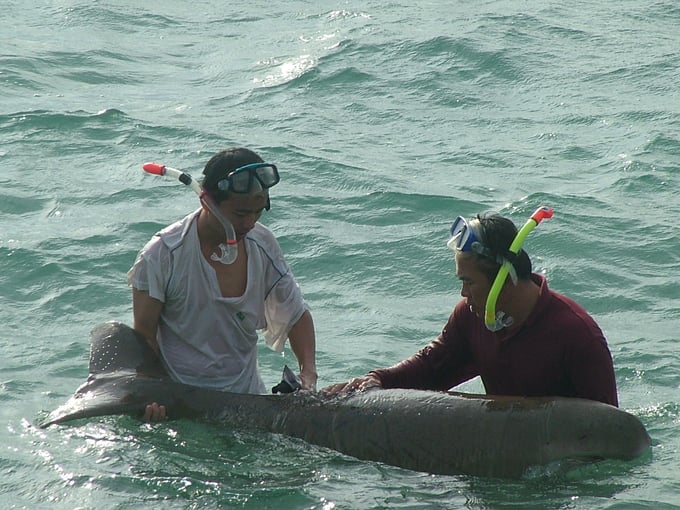June 21, 2025 | 00:58 GMT +7
June 21, 2025 | 00:58 GMT +7
Hotline: 0913.378.918
June 21, 2025 | 00:58 GMT +7
Hotline: 0913.378.918

Bai Cat Lon - Bay Canh Island, Con Dao National Park is the breeding place of many mother turtles during the annual breeding season. Photo: VNA.
Con Dao National Park is encompassed by the Ba Ria-Vung Tau district of Con Dao. This is one of the few national natural conservation areas that preserves the natural splendor of the ecological system. Rich forests and seascapes are the most significant factors in the development of ecotourism in this region.
Con Dao was voted one of the world's top ten most endearing islands by Lonely Planet, and one of the world's most enigmatic islands by Travel and Leisure Magazine. The islands are shaped like mushrooms and are scattered across the wide sea surface. The mushroom tops resemble forest floors, producing a natural image of an aquatic environment.
Con Dao National Park is one of only a handful of national parks to have forest, wetland, and marine ecosystems. The species diversity of marine life in Con Dao is predicated on the diversity of its ecosystems. Coral reefs, with densities spanning from a few hundred to tens of thousands per 100 square meters, are multicolored and produce a vibrant scene in the water.
Approximately 1,500 species have been recorded to date, including more than 300 species of marine vegetation, 350 species of coral, and 900 species of marine life. In the list of Con Dao marine life, 7 species are critically endangered, 67 species are endangered or vulnerable, and over 300 hard coral species are on the CITES list.
In addition to their ecological and aesthetic value, coral reefs and seagrass meadows contribute significant aquatic resources to the waters of Con Dao. In recent years, aquatic exploitation has generated annual profits in the tens of billions of dong. In particular, mackerel and chang fish brought in more than 10 billion VND in revenue.

Hawksbill sea turtles were recorded in Con Dao waters. Photo: VNA.
Con Dao National Park was honored to be recognized as a Wetland of International Importance (Ramsar site) and a member of the Indian Ocean and South East Asia (region) (IOSEA) due to its diverse marine ecosystem. The Vietnam Record Book Center has designated Con Dao National Park as the location in Vietnam where most sea turtles are incubated and released into the wild.
Marine conservation in Con Dao was implemented very early, at the time of the National Park's creation in 1993, when this discipline was still in its inception and marine scientists were conducting research and submitting proposals.
Since its inception, the Management Board of Con Dao National Park has engaged in numerous marine conservation activities, such as managing fisheries exploitation and addressing violations at sea; enhancing staff capacity in the field of management and protection of aquatic resources; training marine patrol teams; and promoting ecotourism in the local community.
The sea turtle conservation and recovery program in Con Dao has been implemented continuously through protection organizations and community education; rescue and research into the biological characteristics of sea turtles; and satellite identification and tracking of turtles.
Non-governmental organizations in Vietnam, primarily the World Wide Fund for Nature (WWF) and the State Bank of Vietnam provide the funds necessary for the implementation of this program.
After 30 years of implementation, the program has documented the arrival of nearly 13,000 mother tortoises and the successful rescue of over 3 million eggs. Approximately 2,500,000 young turtles have been hatched, relocated, and released into the ocean.
The sea turtle conservation and rehabilitation program in Con Dao is considered by domestic and international nature conservation organizations to be the first and most successful sea turtle conservation program in Vietnam and has been awarded a Certificate of Merit by the Prime Minister in recognition of its remarkably exceptional achievements in sea turtle conservation.
In 2019, Con Dao National Park became the 11th member of the Indian Ocean - Southeast Asia Network of Sea Turtle Sanctuaries (IOSEA).
In addition, the project Selecting an application model for hard coral restoration at the Ramsar site of Con Dao National Park was implemented from 2018 to 2020 at a cost of 1.45 billion VND from the provincial budget of Ba Ria - Vung Tau. With community participation, the initiative aims to restore and manage a number of stony coral reefs in the region.
As a consequence, the initiative organized a coral restoration training course for forty individuals, including ten park officials and thirty community members from the Con Dao district. Simultaneously, we have constructed a successful restoration process for over 6,000 coral colonies spanning 3 hectares on natural bottom and artificial reefs at the Ramsar site.
More coral reefs have been restored and regenerated as a result of the project's implementation, aiding the recovery of aquatic species and increasing ecotourism offerings in Con Dao. In addition, increasing the community's fishing produce generates employment opportunities for fishermen to earn more money.

Rescue Dugong, Con Dao National Park in 2007.
On the other hand, the initiative has increased the community's awareness and responsibility to safeguard the marine environment, sustainably develop biodiversity and natural resources, and lessen the overexploitation of Con Dao marine resources.
From 2010 to the present, the People's Committee of Ba Ria - Vung Tau province has invested 19.2 billion VND in a project to improve the capacity to manage, protect, and develop the aquatic resources of Con Dao National Park, thereby assisting officials with management and expertise to increase their capacity and knowledge regarding marine biodiversity conservation.
More than 200,000 officials, soldiers, communities, tourists, students, and fishermen have been informed of the Law on Fisheries by National Park officials in recent years. Due to this, the natural environment of Con Dao is always pure, attractive, and secure, with no illegal exploitation, use of prohibited fishing equipment, or dumping of refuse into the sea.
Con Dao National Park has fulfilled the mission of a Special Use Forest for the past 30 years by preserving natural forest ecosystems, preserving precious and rare genetic resources of forest and marine creatures, and preserving historical relics, scientific research, and ecotourism.
Translated by Dieu Linh
![Turning wind and rain into action: [9] Digitizing hydrometeorological data in response to climate change](https://t.ex-cdn.com/nongnghiepmoitruong.vn/608w/files/news/2025/06/17/z6704423696987_15fd32ffc26d590d204d520c9dac6786-nongnghiep-165943.jpg)
(VAN) Farmers have begun accessing hydrometeorological applications to adjust their cropping schedules, aiming to ensure productivity and adapt to climate change.
![Turning wind and rain into action: [8] Real-time salinity detection and early warning technology](https://t.ex-cdn.com/nongnghiepmoitruong.vn/608w/files/news/2025/06/17/z6704423696987_15fd32ffc26d590d204d520c9dac6786-nongnghiep-151127.jpg)
(VAN) Thanks to the integration of modern hydrological-hydraulic models, remote sensing technologies, and artificial intelligence, the accuracy of hydrological forecasting has significantly improved.
![Turning wind and rain into action: [7] Early disaster warnings help marine farmers minimize losses](https://t.ex-cdn.com/nongnghiepmoitruong.vn/608w/files/news/2025/06/17/z6704423696987_15fd32ffc26d590d204d520c9dac6786-nongnghiep-142942.jpg)
(VAN) In recent years, thanks to early disaster warnings and forecasting, marine farmers in Khanh Hoa province have been able to reduce risks and losses, thereby improving production efficiency.
![Turning wind and rain into action: [6] ‘Four on-the-spot’ disaster management software](https://t.ex-cdn.com/nongnghiepmoitruong.vn/608w/files/news/2025/06/17/e5a48259d6a262fc3bb3-nongnghiep-183800.jpg)
(VAN) By simply activating the scenario on the disaster management software, the relevant authorities immediately know how many households need to be evacuated, where to evacuate them to, and by what means of transportation…
![Turning wind and rain into action: [5] Hue applies modern technology in disaster forecasting](https://t.ex-cdn.com/nongnghiepmoitruong.vn/608w/files/news/2025/06/17/z6704423696987_15fd32ffc26d590d204d520c9dac6786-nongnghiep-093938.jpg)
(VAN) In Hue city, modern technology has recently been applied in meteorological and hydrological forecasting and warning, helping to reduce the damage caused by natural disasters.

(VAN) A cutting-edge farming technique being implemented on an experimental ranch in Arizona's Sonoran Desert has already saved a billion gallons of water over five years, according to Civil Eats.

(VAN) Poultry and pig production and the environment can be boosted through enhanced water technology, according to new research.